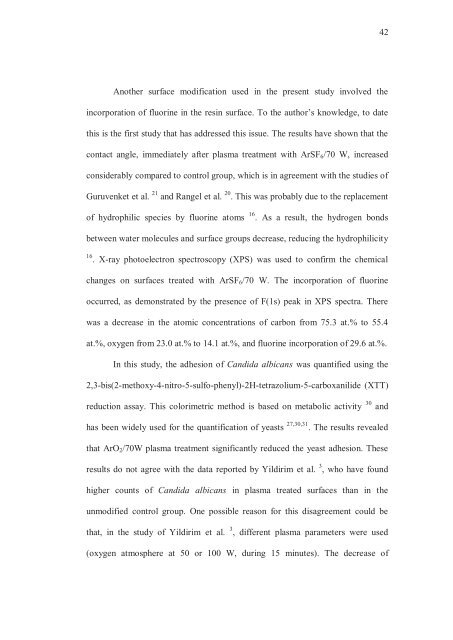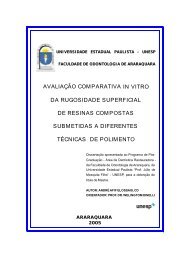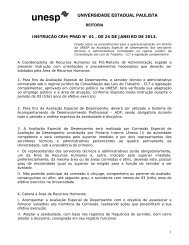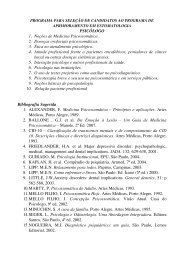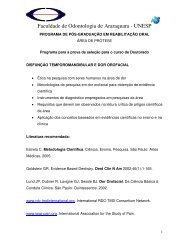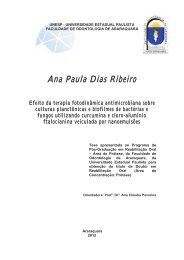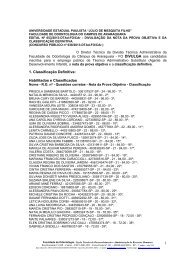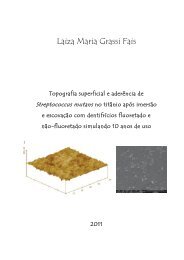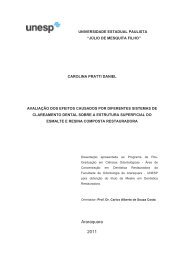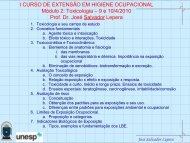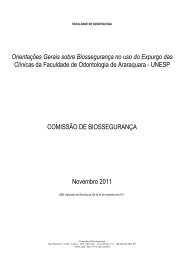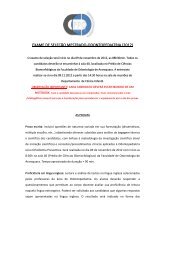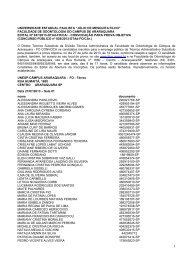universidade de são paulo - Faculdade de Odontologia - Unesp
universidade de são paulo - Faculdade de Odontologia - Unesp
universidade de são paulo - Faculdade de Odontologia - Unesp
Create successful ePaper yourself
Turn your PDF publications into a flip-book with our unique Google optimized e-Paper software.
42<br />
Another surface modification used in the present study involved the<br />
incorporation of fluorine in the resin surface. To the author’s knowledge, to date<br />
this is the first study that has addressed this issue. The results have shown that the<br />
contact angle, immediately after plasma treatment with ArSF 6 /70 W, increased<br />
consi<strong>de</strong>rably compared to control group, which is in agreement with the studies of<br />
Guruvenket et al. 21 and Rangel et al. 20 . This was probably due to the replacement<br />
of hydrophilic species by fluorine atoms 16 . As a result, the hydrogen bonds<br />
between water molecules and surface groups <strong>de</strong>crease, reducing the hydrophilicity<br />
16 . X-ray photoelectron spectroscopy (XPS) was used to confirm the chemical<br />
changes on surfaces treated with ArSF 6 /70 W. The incorporation of fluorine<br />
occurred, as <strong>de</strong>monstrated by the presence of F(1s) peak in XPS spectra. There<br />
was a <strong>de</strong>crease in the atomic concentrations of carbon from 75.3 at.% to 55.4<br />
at.%, oxygen from 23.0 at.% to 14.1 at.%, and fluorine incorporation of 29.6 at.%.<br />
In this study, the adhesion of Candida albicans was quantified using the<br />
2,3-bis(2-methoxy-4-nitro-5-sulfo-phenyl)-2H-tetrazolium-5-carboxanili<strong>de</strong> (XTT)<br />
reduction assay. This colorimetric method is based on metabolic activity 30 and<br />
has been wi<strong>de</strong>ly used for the quantification of yeasts 27,30,31 . The results revealed<br />
that ArO 2 /70W plasma treatment significantly reduced the yeast adhesion. These<br />
results do not agree with the data reported by Yildirim et al. 3 , who have found<br />
higher counts of Candida albicans in plasma treated surfaces than in the<br />
unmodified control group. One possible reason for this disagreement could be<br />
that, in the study of Yildirim et al. 3 , different plasma parameters were used<br />
(oxygen atmosphere at 50 or 100 W, during 15 minutes). The <strong>de</strong>crease of


